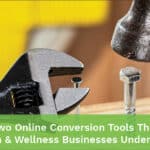Make this the year you transform run-of-the-mill “marketing chores” into super-effective digital marketing and online engagement that grows customers and revenues in your health club.
Resolution #1: Respond FAST to emails, texts, direct messages, chats & reviews
Simple, but not easy. Resolve to respond to every online interaction you get during business hours FAST. Really fast.
Seconds, not minutes.
Minutes, not hours.
Hours, not days.
Days, not weeks or months.
This includes but isn’t limited to:
- The general inquiry email inbox for your business
- Your Facebook business page messages
- Text messages to your business
- Reviews of your business
- Voicemails for your business
- Chat apps on your website
All of them. FAST.
If a potential client walked through your door, would you ignore them for four or five hours? Two or three days? A month? No way!
A total stranger has taken the initiative to reach out to your business. That means they’re actively thinking about paying someone to help them with their health and wellness.
Don’t you want that someone to be your business?
Every second you wait is time for your potential member to check out a competitor, get distracted or forget about you — or kick you to the curb because you’re not responsive.
When people reach out via email, texts, chat, reviews or direct messages, picture them walking through the door of your business.
And treat them accordingly.
Resolution #2: Commit to keeping the online conversation going
You can do better than just a fast click of the Like button on your company’s Facebook page every time someone comments.
You can do better than cutting and pasting the same boilerplate every time someone has a gripe on Yelp: “Thank you for your feedback. We want every client to have a memorable experience and hope you will allow us to endeavor to exceed your expectations in the future.”
We challenge you to commit to keep the conversation going.
This means responding with a question or other open-ended comment that invites and encourages them to deepen their interaction with you.
It also means engaging with specific information in their reply, not relying on generic one-size-fits-all responses.
When someone posts “So glad I can finally fit my heavy coat in the new lockers”, consider which of these responses is likelier to keep the conversation going:
“Great!”
OR
“So glad the new lockers worked better for winter coats, what did you think about the larger benches with more room to spread stuff out?”
Keep talking.
Why? Every successful health club owner knows that it’s cheaper to keep existing members than to get new ones. But to do that, you have to know as much as possible about what your current customers are thinking. Then:
- You can focus and invest in the areas that matter most
- Your customers feel important, valued and appreciated
- You can fix any problems before they chase customers away
But that kind of engagement only happens if when sincere interest and a spirit of inquiry are present.
Customers are trying to tell you that they love the fact that you have extended swim hours, or your coaches listen, or you have a nice quiet yoga room that isn’t shared on alternate days by a group ex fitness class, or…
That they hate the fact that you don’t pick up dirty towels, the sauna hasn’t worked in a week, there’s a funny smell in the family locker room, the parking lot feels dark and menacing, and the burned-out lights in the basketball court haven’t been fixed since October.
If it’s good news, you should be harvesting it, sharing it, and pointing folks to it. If it’s bad news, you should be dealing with it before it spreads like a nasty winter cold.
And on a more mundane level, keeping the conversation going does a much better job of “feeding the beast” — the algorithms that Facebook, Google and other platforms rely on to make your online presence more visible.
Resolution #3: Capitalize on social ad and boosted post responses
The great thing about advertising on social media is that folks can actually comment on your ads. It’s like a walk-in prospect who stops and talks with you instead of just picking up a brochure and scurrying out again as quickly as possible.
In both cases, customer engagement is organic. They see something of interest and choose to become part of the conversation.
It’s OK if your club isn’t right for them. Maybe you’re too focused on exercise basics, diet, HIIT, weightlifting, or some other specialty.
Finding that out is part of the reason they were talking to you. Plus, your club might be right for someone they know.
Remember, in social, dozens, hundreds, thousands of people may see your exchange! Or at least all the people connected to your business, and all the people connected to the person who commented.
PRO TIP: Remember that these are sales conversations. Your business effectively paid for every one of these post or ad engagements.
So when you respond, make sure you add information or further uncover the needs and priorities of your prospective client.
In our earlier example, we worked in the point that our roomy benches let you spread your stuff out. We did more than just talk about the locker’s size. That’s an example of this technique.
Your goal is always to move the sales process forward — either for the original commenter, if they’re a prospect, or for someone else who’s listening.
Make sure it delivers the sales and marketing result you really want.
Just as you would in person, keep it friendly and sincere, answer any specific questions fully, ask plenty of questions, and point people to useful content when you can. Chime in with your own thoughts and perspectives as a business owner or manager, maintain prospect interest, and don’t be afraid to be authentic.
Resolution #4: Leverage unique strengths of each social platform
Facebook & Instagram
These platforms are all about consumers, and they’re your best bet for connecting with current and potential members, clients and customers.
If you’re a B2C wellness business, you need to be here — posting organically and investing in paid advertising campaigns.
Business prospects and customers — If you’re a B2B wellness business — for example, an employee wellness provider — you need to post and advertise on LinkedIn.
Strategic alliances and potential investors — LinkedIn’s one of the first places these folks will check you, personally, out. And it’s the best place to raise your profile and perceived authority among your peers in your specific corner of health and wellness.
Potential employees — again, the first place candidates will check out your club’s management and leadership.
Yelp
Still important if you sell to consumers — because anyone checking your business out on Yelp is THIS close to making a purchase.
That’s why paying Yelp $75/month to suppress competitor ads on your Yelp profile and give you a special Call to Action feature (perfect for an introductory offer) is worth considering.
Twitter’s about opining, not selling — so if you want to rant about sugary soda, this is where you do it.
(Note: the target audience is usually your professional peers, not your potential clients or customers. If revenue’s your goal, you can probably skip Twitter entirely.)
Resolution #5: Put your online presence on a formal refresh cycle
Too many wellness businesses give the “set it and forget it” treatment to their websites and profiles on Google Business, Facebook, Yelp, and LinkedIn, as well as important referral sites. For example, PsychologyToday.com’s profiles are an important source of clinician referrals.
In 2018, create an explicit review-and-refresh schedule. At least twice yearly, review your online presence for:
Completeness
Are all the fields in your social profile completed? Leave nothing blank.
Without completed profiles, your club won’t show up properly in Google My Business, Facebook or Yelp search results.
Potential customers won’t find it as easy to stop by, tap to get directions, or click-to-call your club after searching for “Bikram yoga in Caruthersburg.”
Facts
Are all the key facts present and correct? This includes everything from logistics — hours, address, contact details — to the actual programs and services you offer.
Did you start or stop offering baby-and-me yoga? Have you added or closed a location? Did your hours change?
Are your team’s LinkedIn profiles current — for example, do they all reflect your business as their current employer?
Check your images, too: for example, do you need to remove photos of former team members, or replace outdated logos on third-party sites?
Here’s one many businesses overlook. Most social platforms also let businesses specify their holiday schedule each year. You should update this rather than showing business hours on Monday, December 25 as if it were any other Monday.
Persuasive
Your website obviously has lots of persuasive copy intended to transform prospects into customers.
However, fields like “Description” on social profiles should be persuasively written as well. Boring historical trivia like “Founded in 2011” should not be the focus of fields that let you describe your business.
Include any promotional offers like your Yelp call-to-action in your review-and-refresh cycle, and make sure the copy’s as persuasive and compelling as possible.
A second ago we mentioned visits to your Directions page. Your club’s current address, phone number, and hours should be located within plain view on your website. Ideally, the first page prospective customers visit, for obvious reasons — you want customers to find you!
Right?
But they might not visit your website directly. These days, they’re just as likely to simply search for “MyClub locations near me” or even just “health clubs.”
These platforms spread the word about who you are, where you are, and why you’re in business. Without them, you’re depending on someone else to tell your story for you.
Keep these core principles of online engagement in mind to capitalize on strong prospect interest, improve retention, reduce sales friction, and keep your “well-oiled machine” up and running.



